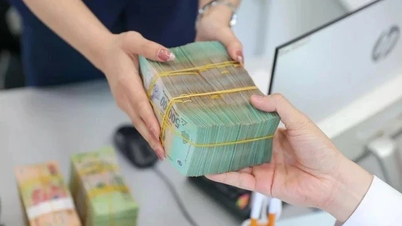
Resident deposits in the banking system decreased for the first time after more than two years of continuous increase.
According to the State Bank of Vietnam's data updated by the end of January 2024, people's deposits in banks reached about 6.5 million billion VND. This level decreased by nearly 35,000 billion compared to the beginning of the year, equivalent to more than 0.5%.
Previously, since the end of 2021, this cash flow has been continuously increasing, averaging over VND50,000 billion per month. With new data from the operator, residents' deposits have decreased for the first time in more than two years.
Similarly, businesses and organizations also reduced their deposits in banks, at 6.67 trillion VND as of the end of January. This level is 165 trillion VND less than at the beginning of the year, a decrease of over 2.4%.
Meanwhile, according to data from the General Statistics Office as of March 25, capital mobilization (including residents and organizations) of credit institutions decreased by 0.76% compared to the beginning of the year, while in the same period last year it increased by nearly 1.2%.
Thus, after the period of massive deposits, the cash flow into the banking system has shifted in the face of a prolonged low interest rate environment. The average interest rate mobilized at most banks does not exceed 5% per year. For short-term deposits of a few months, the interest rate fluctuates between 2-4% per year, the lowest level in many years.
On the other hand, people's investment tastes have also changed somewhat in the context of volatile financial markets. They choose channels with better profit rates to "put money in". For example, since the beginning of the year, gold has generated a profit of 14.8-22.3%, better than stocks and savings, which have generated 12.8% and 1.2%, respectively.
In this context, to retain depositors, many banks are moving to increase deposit interest rates, instead of decreasing them as before. Thanks to that, the liquidity of the banking system is abundant in the context of credit growth being more limited than in previous years.
Quynh Trang
Source link



![[Photo] Many people eagerly await the preliminary review despite heavy rain](https://vphoto.vietnam.vn/thumb/1200x675/vietnam/resource/IMAGE/2025/8/27/4dc782c65c1244b196890448bafa9b69)
![[Photo] Brilliant red of the exhibition 95 years of the Party Flag lighting the way before the opening](https://vphoto.vietnam.vn/thumb/1200x675/vietnam/resource/IMAGE/2025/8/27/e19d957d17f649648ca14ce6cc4d8dd4)
![[Photo] Prime Minister Pham Minh Chinh chairs meeting of National Steering Committee on International Integration](https://vphoto.vietnam.vn/thumb/1200x675/vietnam/resource/IMAGE/2025/8/26/9d34a506f9fb42ac90a48179fc89abb3)































































![[Photo] General Secretary To Lam attends Meeting with generations of National Assembly deputies](https://vphoto.vietnam.vn/thumb/402x226/vietnam/resource/IMAGE/2025/8/27/a79fc06e4aa744c9a4b7fa7dfef8a266)
































Comment (0)